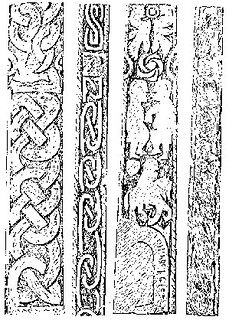Crowle Stone

The Crowle Stone is an important fragment of a decorated Anglo-Saxon cross shaft or monument. It’s survival is due to Norman masons reusing it when the church was rebuilt in the 12th century. The stone is Millstone Grit, and is likely to have come from near Knaresborough.
It was first recorded in the mid 19th century and was removed, and subsequently replaced, in 1869 for a full examination by Rev J T Fowler who reported his findings to the Society of Antiquaries in London. The stone was taken out permanently in 1919, although it was originally placed at the back of the church under the arcade between the Nave and North Aisle. It was in 2010 during the reordering of the church that the stone was moved to its current location, where it can be clearly seen.

The main decorated face depicts a pair of creatures, possibly birds, facing each other.
Between them is a small circular disc with concentric incised inner ring and visible centre point. Below this is circular form that could represent the Sun. Under this are two men facing each other. One appears to be grasping the hilt of a of a sword as if to draw it from its scabbard. Below these is the figure of a bearded horseman.
At the bottom is a broad raised band that appears to curve like an arch although only the right portion remains. On this ribbon is the runic inscription, first described by Fowler.
Much of the original surface of the stone has been cut away, leaving rough diagonal score marks, possibly caused by the Norman masons when they were fitting the stone into the wall as a lintel. As a result much of the runic inscription has been obliterated, and all that remains is a fragment of the original inscription.
The Victorian antiquarians disagreed on the meaning of the inscription. However, recent scholarly study of the stone in the Corpus of Anglo Saxon Stone Sculpture, suggests that this is an Anglo-Saxon variety of runic script and that the word ‘bæcun’ shows that the language is Old English. The discussion suggests that a possible interpretation of the inscription reads ‘corpse monument’ or gravestone.
Its appearance would date it after the last quarter of the ninth century. Early interpretations of the images on the stone attempted to give them Christian meaning, and it has been suggested that it depicts St Paul and St Anthony meeting in the desert and the flight into Egypt or Noah entering and leaving the Ark.
The Corpus of Anglo Saxon Stone Sculpture suggests that, because of the general Scandinavian and lordly representation of the decorative scheme, it is most likely to be part of the story recognisable to contemporaries. A suggestion is that the images represent Sigurd from the Volsunga Saga which includes elements of birds, the encounter of Sigurd and Mimir and Sigurd’s journey on his horse Grani to kill the dragon Fafnir.

Hi there, I was wondering for the source on the final drawing of the four faces of the cross? Cheers!
– Alex H
Hi Alex,
Apologies I have only just seen your comment. The Drawing comes form the paper by Rev George S Tyack on The Crowle Stone and can be found in Bygone Lincolnshire, which was published in 1891. I can send you a copy of the article if you wish.
Thank you . When is the church open to view the stone?
Apologies – I’ve only just seen your post. Unfortunately, like many churches these days, the church is not usually open except for services. The churchwardens will open up if you want to visit and see the stone. Their details can be found on the church website, http://www.stoswalds-crowle.co.uk/